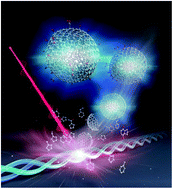Fabrication of ultra-bright carbon nano-onions via a one-step microwave pyrolysis of fish scale waste in seconds†
Abstract
Carbon nano-onions (CNOs), one of the most promising carbon nanoforms, have drawn interest worldwide and have been applied extensively in electronics, photovoltaics, catalysis, and biomedical diagnostics. Conventional synthetic techniques of CNOs require harsh experimental conditions, such as high temperature and vacuum, are time consuming, or require high-cost carbon sources, extra catalysts, and hazardous strong acids/bases; these are significant drawbacks that hinder the facile synthesis of CNOs. Herein, we report a novel preparation of ultra-bright CNOs via a one-step microwave pyrolysis of fish scale waste within seconds. Simultaneous surface functionalization of CNOs is also established at the synthesis stage. The highly crystallized multiple-shelled core-state and well-functionalized surface of the obtained CNOs facilitates a visible photoluminescence with a narrow emission width less than 90 nm and a superior quantum yield of 40%, which is the highest value and 10-fold higher compared with the existing CNOs conventionally prepared via the much more complicated approaches. Excellent dispersibility along with a steady emission in various polar solvents and solid-state lighting applications such as blue-light-emitting flexible film and LED was also achieved. The presented super-facile and versatile synthetic technique for high-performance CNOs presents a novel opportunity for the green and sustainable synthesis of advanced functional nanomaterials.



 Please wait while we load your content...
Please wait while we load your content...